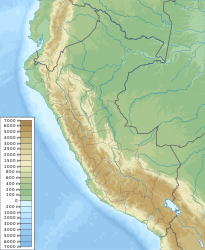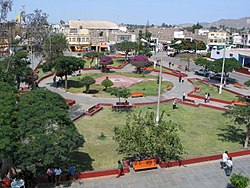Nasca (Peru)
| Nasca | ||
|---|---|---|
|
|
||
| Coordinates | 14 ° 50 ′ S , 74 ° 56 ′ W | |
| Symbols | ||
|
||
| Basic data | ||
| Country | Peru | |
| Ica | ||
| province | Nasca | |
| ISO 3166-2 | PE-ICA | |
| District | Nasca | |
| height | 520 m | |
| Residents | 22,859 (2017) | |
| founding | November 17, 1591 | |
| Website | www.muninasca.gob.pe (Spanish) | |
| politics | ||
| mayor | Julio Oscar Elías Lucana (2019-2022) |
|
|
Plaza de Armas in Nasca
|
||
Nasca (old spelling: Nazca ) is a city with about 23,000 inhabitants (2017 census) in Peru , located about 450 km south of Lima directly on the Panamericana . The coast of the Pacific is about 50 kilometers away. Nasca is the capital of the Nasca province in the Ica region .
The city owes its economic boom to the famous Nazca Lines , which have been a UNESCO World Heritage Site since 1994 . The lines and ground drawings ( geoglyphs ) in the Nazca plain were created by the bearers of the Nazca culture .
Tourism has been developing for years. There are numerous hotels and restaurants. Nasca also has a small airport , from where u. a. Sightseeing flights start over the Nazca Lines. Travel agencies arrange flights across the desert to visit the Nazca Lines.
literature
- Dietrich Schulze, Viola Zetzsche: Picture book of the desert. Maria Reiche and the floor drawings of Nasca. Mitteldeutscher Verlag, Halle 2005, ISBN 3-89812-298-0 .
Individual evidence
- ↑ PERU: Region Ica - Provinces & Places . www.citypopulation.de. Retrieved December 28, 2019.




